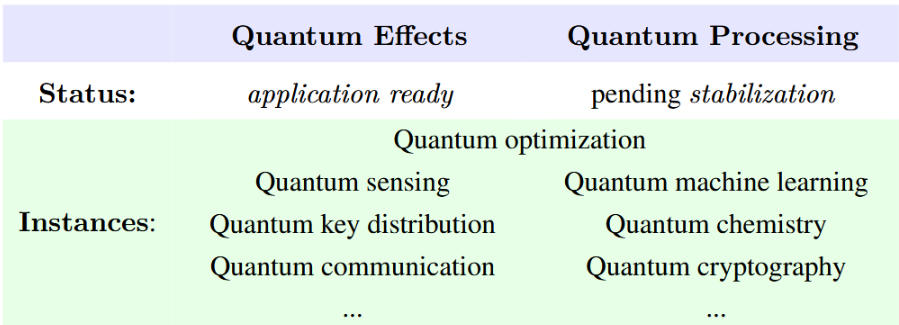nLab quantum technology
Context
Quantum systems
-
quantum algorithms:
Contents
Idea
While much of contemporary technology is based on effects of quantum physics — transistors notably, hence electronic computers, but also lasers and much more — these results of the technological “first quantum revolution” still largely operate on macroscopic quantum systems. Under quantum technologies proper one now understands – anticipating or already beholding a “second quantum revolution” (Dowling & Milburn 2003) – technologies which make use of (arrangements of) individual and individually controlled coherent quantum systems, such as in the archetyical form of individual qbits.
Among quantum technologies (existing or anticipated) one counts notably
and, ultimately, universal
and other incarnations of quantum information theory in quantum materials.
Often underappreciated is that quantum technologies appear in two kinds, which may be called (following CQTS):

(1.) quantum effects, relying on single (even if oft repeated) quantum events (such as single quantum measurements),
(2.) quantum processes, being the more delicate coherent concatenation of many quantum events.
The key practical difference is that quantum effects are application-ready and are already being commercially applied (e.g. in quantum key distribution), while for quantum processes (most forms of quantum computing) to scale-up beyond toy examples (namely beyond current “NISQ” machines) will require solutions to the problem of stabilization or error suppression, either after the fact by software-level quantum error correction, or, more ambitiously, right at the hardware-level by fundamental quantum topology (“topological quantum computing”).
References
-
Jonathan P. Dowling, Gerard J. Milburn: Quantum Technology: The Second Quantum Revolution, Phil. Trans. Roy. Soc. A – Math. Phys. & Engineering Sciences 361 1809 (2003) [arXiv:quant-ph/0206091, doi:10.1098/rsta.2003.1227]
-
Lars Jaeger: The Second Quantum Revolution – From Entanglement to Quantum Computing and Other Super-Technologies, Springer (2018) [doi:10.1007/978-3-319-98824-5]
-
NIST Physics: The Second Quantum Revolution (2018,2022)
-
Ivan H. Deutsch: Harnessing the Power of the Second Quantum Revolution, PRX Quantum 1 (2020) 020101 [doi:10.1103/PRXQuantum.1.020101]
-
Helmholtz Quantum: Researching the Second Quantum Revolution — Quantum Technologies in the Helmholtz Association (2021) [pdf]
-
Daniel Garisto: The second quantum revolution, Symmetry Magazine (2022)
-
Intoni et al.: The Second Quantum Revolution: Unexplored Facts and Latest News, MDPI Encyclopedia 4 2 (2024) 630-671 [doi:10.3390/encyclopedia4020040]
-
Physics@MIT: The Next Quantum Revolution (2024)
See also:
-
Wikipedia: Quantum engineering
-
Materials for Quantum Technology (Journal), IOP Science
Last revised on August 21, 2025 at 09:35:51. See the history of this page for a list of all contributions to it.